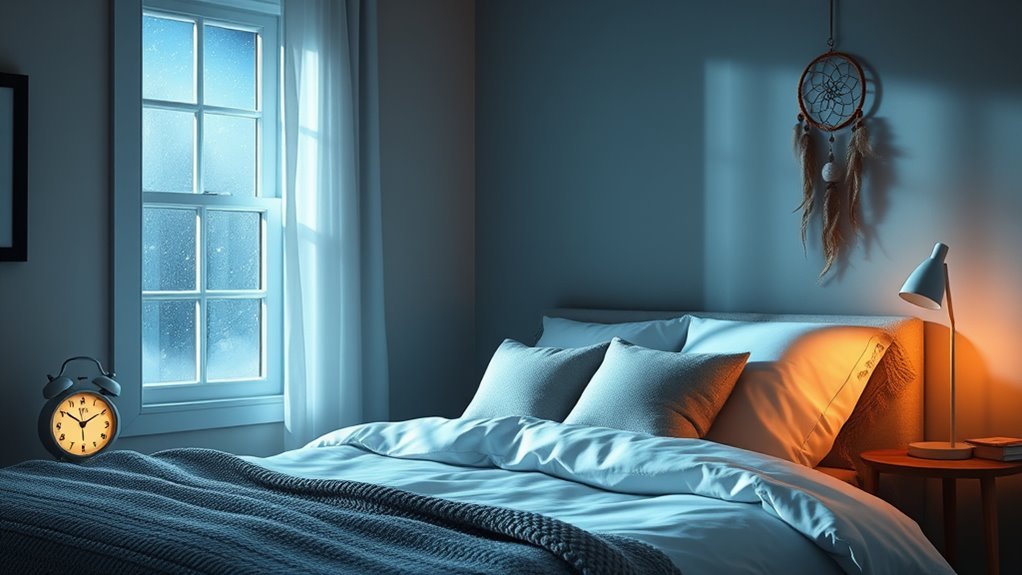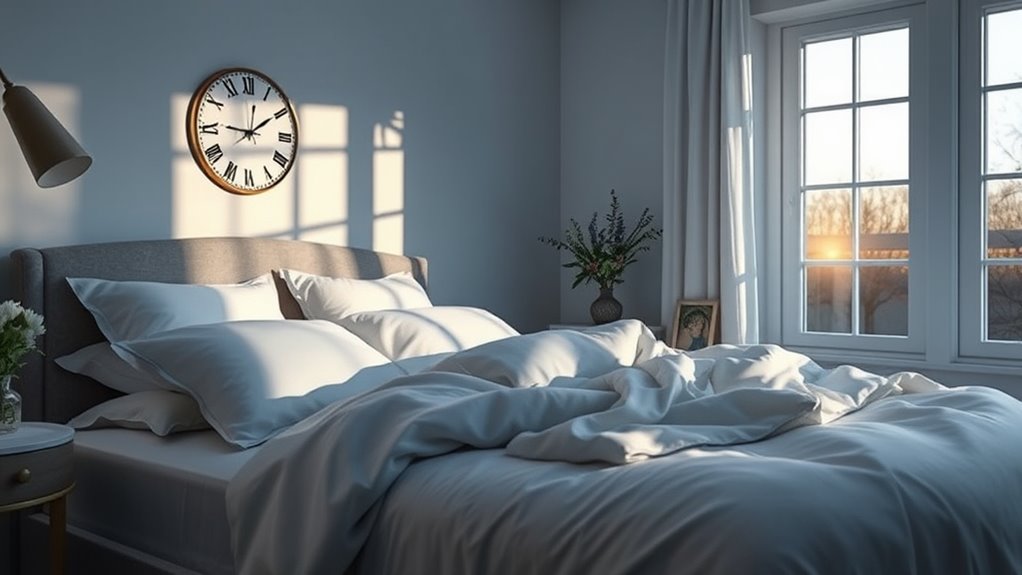Understanding sleep architecture is essential to feeling rested. Your sleep cycles include non-REM and REM stages, each serving a specific purpose. Light sleep shifts you to deeper rest, while deep sleep repairs your body and boosts immunity. REM sleep aids memory and emotional regulation. You typically go through 4 to 6 cycles a night, with increasing REM time. By enhancing your sleep environment and habits, you can optimize this process for better energy and well-being. Discover more insights on improving your sleep!
Key Takeaways
- Sleep architecture consists of NREM and REM stages, each playing a crucial role in physical and mental health.
- A typical sleep cycle lasts about 90 minutes, including all sleep stages, and most people experience 4 to 6 cycles per night.
- Deep sleep is essential for physical restoration, while REM sleep supports cognitive functions like memory consolidation and emotional regulation.
- Maintaining a consistent sleep schedule and creating a comfortable sleep environment can enhance sleep quality and support healthy sleep architecture.
- Understanding your sleep stages enables targeted adjustments to improve restfulness and overall well-being.

Sleep Architecture
Have you ever wondered how your brain organizes sleep? Understanding your sleep architecture can help you feel more rested and energetic throughout the day. Your sleep doesn’t just happen; it follows a structured pattern that involves various sleep stages, each playing a crucial role in your overall well-being.
As you drift off, your brain transitions through different stages. These stages are broadly categorized into two types: non-REM (NREM) and REM sleep. NREM sleep itself consists of three stages, where each stage deepens your rest. In the first stage, you’re in that drowsy, half-awake state. You might still be aware of your surroundings, but your body is starting to relax. The second stage marks deeper sleep, where your heart rate slows and body temperature drops. This is where your brain starts to prepare for the more restorative stages to come.
As you drift into sleep, your brain navigates essential stages, transitioning from light drowsiness to deeper, restorative rest.
The third stage of NREM sleep is where the magic happens. It’s often referred to as deep sleep or slow-wave sleep. During this time, your body focuses on repairing tissues, building bone and muscle, and bolstering your immune system. If you’ve ever woken up feeling refreshed, it’s likely because you spent enough time in this stage.
After cycling through these NREM stages, your brain shifts into REM sleep. This stage usually kicks in about 90 minutes after you first fall asleep. In REM sleep, your brain becomes more active, and this is when most dreaming occurs. Your heart rate increases, and your eyes move rapidly beneath your eyelids. This stage is essential for cognitive functions like memory consolidation, problem-solving, and emotional regulation. If you’re missing out on REM sleep, you might find it harder to concentrate or remember things the next day.
Throughout the night, you’ll cycle through these sleep stages multiple times, usually around four to six cycles, depending on how long you sleep. Each cycle lasts about 90 minutes, with the proportion of REM sleep increasing in later cycles. If you’re looking to improve your overall sleep quality, understanding these stages can help you make adjustments. Prioritizing a consistent sleep schedule, creating a comfortable sleep environment, and managing stress can enhance your sleep architecture, leading to ideal rest. So, the next time you hit the pillow, remember the essential work your brain is doing to keep you healthy and alert.
Frequently Asked Questions
How Does Age Affect Sleep Architecture and Cycles?
Age affects sleep architecture and cycles markedly. As you age, you experience developmental changes that impact your sleep patterns. You’ll notice an age-related decline in the quality of your sleep, leading to lighter sleep and more awakenings throughout the night. Deep sleep stages become shorter, making it harder for you to feel fully rested. Understanding these shifts can help you adapt your sleep habits for better rest as you grow older.
Can Diet Influence Sleep Quality and Architecture?
Yes, your diet can substantially influence sleep quality and architecture. Foods rich in nutrients, like magnesium and tryptophan, promote better rest, while heavy meals can disrupt it. If you focus on balanced nutrition, incorporating fruits, vegetables, and whole grains, you’re likely to see improvements in how well you sleep. Avoiding caffeine and alcohol close to bedtime also helps enhance your sleep cycle, leading to more restorative nights. Prioritize your nutrition for better rest!
What Are Common Sleep Disorders Affecting Sleep Architecture?
Common sleep disorders that affect sleep architecture include insomnia and REM disturbances. If you’re struggling with insomnia patterns, you might find it hard to fall or stay asleep, disrupting your sleep cycle. REM disturbances can lead to fragmented sleep, impacting your overall restfulness. Addressing these issues through lifestyle changes or professional help can improve your sleep quality and restore balance to your sleep architecture, helping you feel more refreshed in the morning.
How Do Medications Impact Sleep Cycles?
Medications can substantially impact your sleep cycles. Many drugs come with side effects that disrupt your sleep cycle, making it harder to achieve restful sleep. For instance, certain antidepressants or antihistamines may cause drowsiness but can also lead to fragmented sleep. It’s essential to monitor how your body reacts to medication and communicate any issues with your healthcare provider. Finding the right balance can help minimize sleep disturbances and improve overall restfulness.
Can Napping Disrupt My Sleep Architecture?
Imagine your sleep as a delicate orchestra. Napping can sometimes throw off its rhythm. If you nap too long, you risk hitting sleep inertia, which leaves you groggy and disoriented. A brief, 20-minute nap can rejuvenate you without disrupting your nighttime sleep architecture. However, longer naps can lead to confusion among your sleep cycles, making it harder to conduct a harmonious night of restorative rest. Keep it short, and your sleep symphony will thrive.
Conclusion
Understanding your sleep architecture is essential for feeling truly rested. By recognizing the stages of your sleep cycle, you can optimize your rest and wake up revitalized. Don’t underestimate the power of quality sleep—it’s like a superpower that can transform your entire day! So, pay attention to your body’s signals, create a bedtime routine, and make the most of those precious hours. Your well-being deserves it, and you’ll be amazed at the difference it makes!










